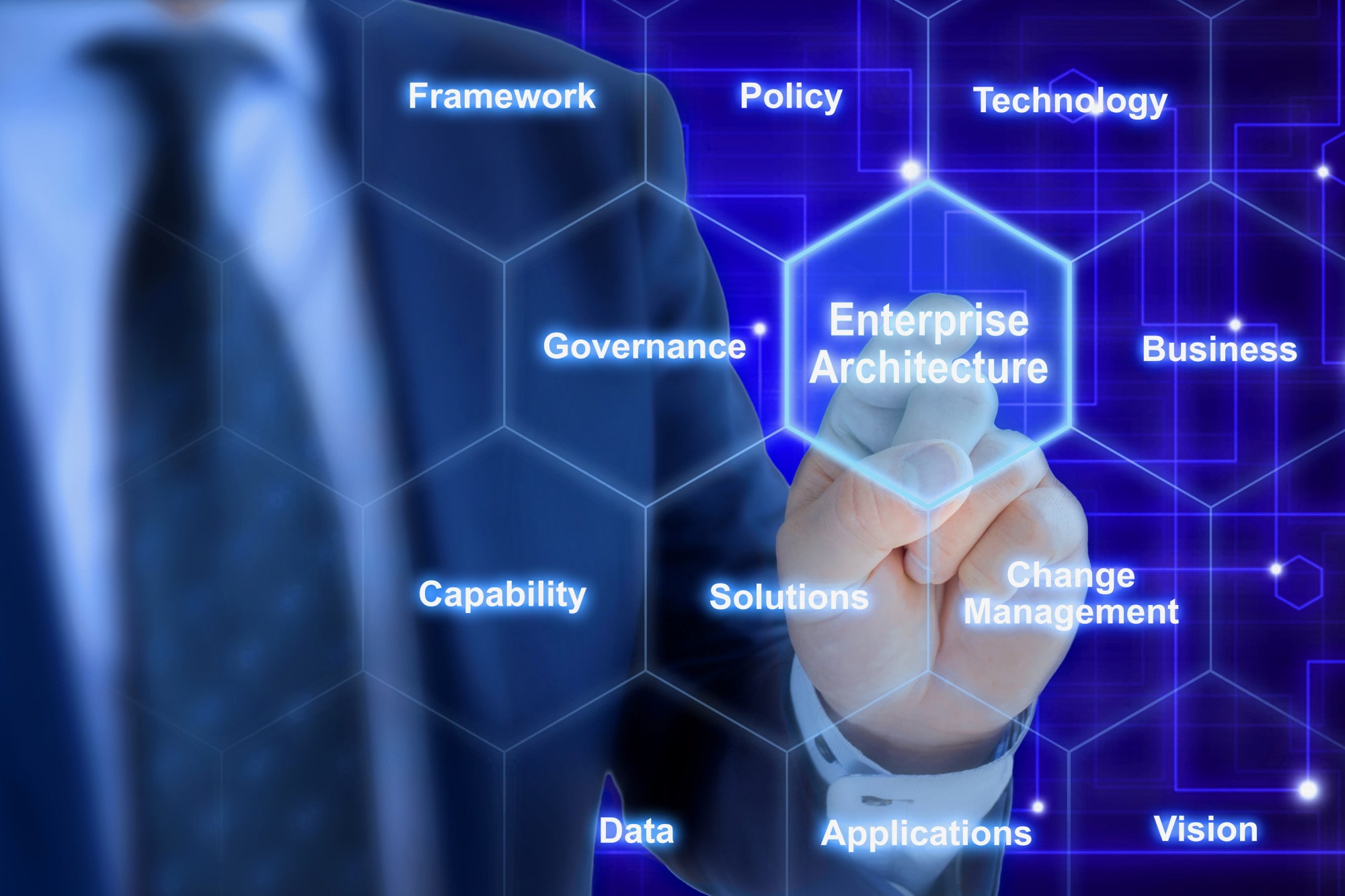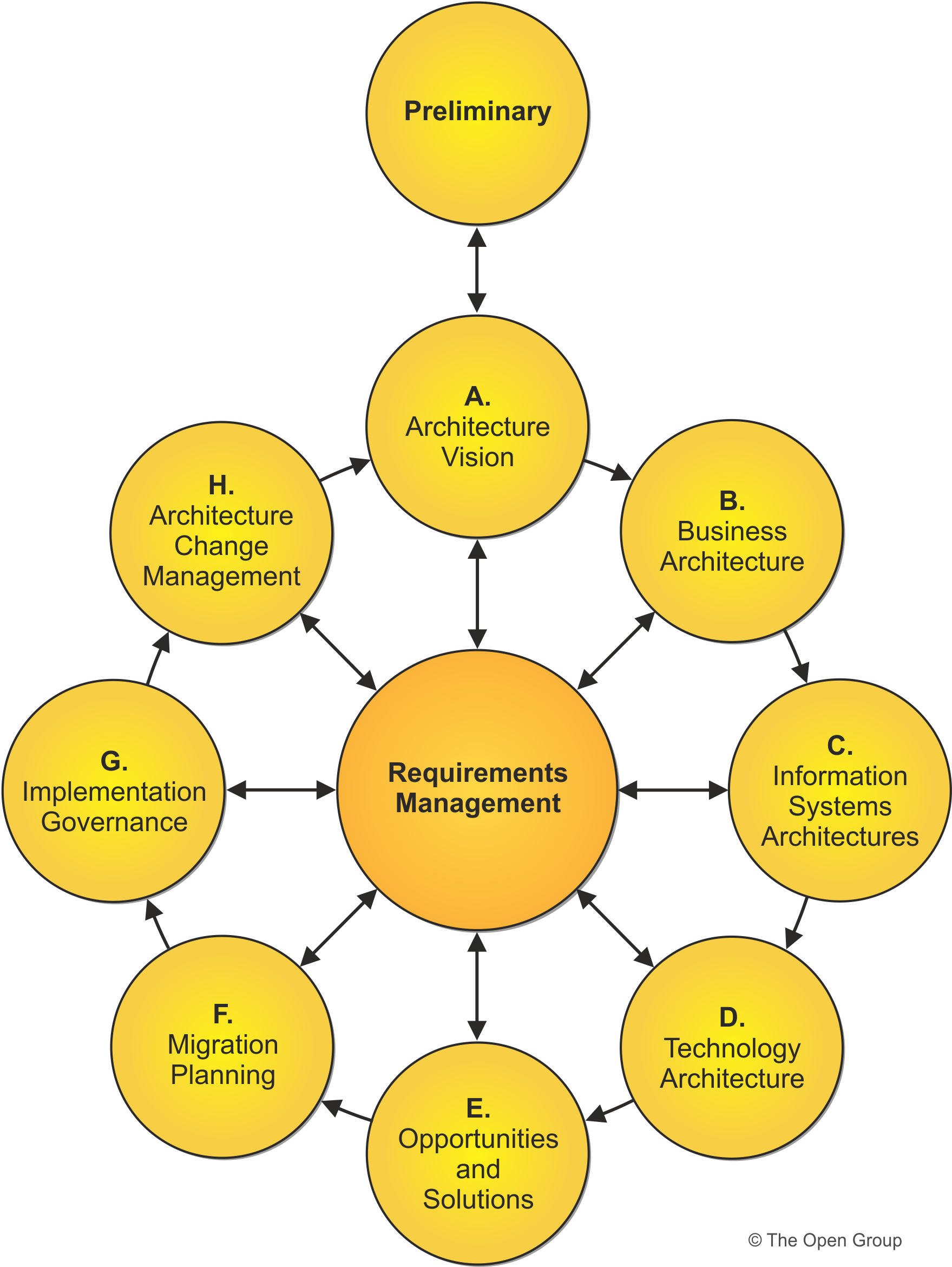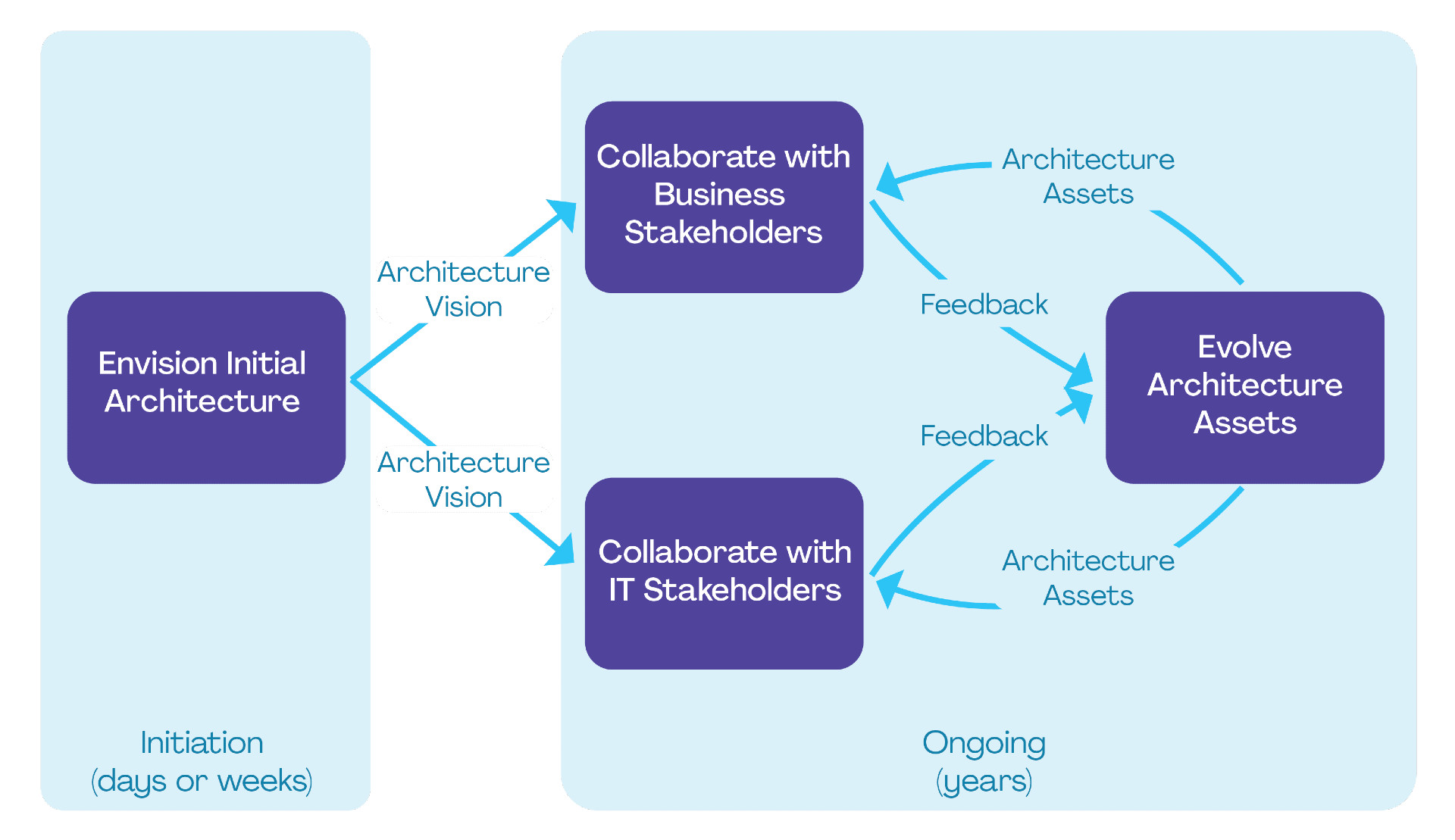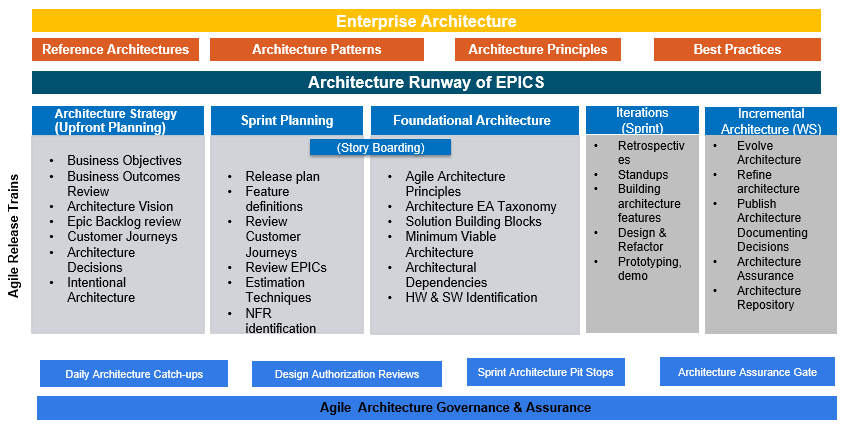
Why Enterprise Architecture?

Architecture principles hold true in agile environments. The major difference between older traditional approaches and modern agile ones is the way of performing enterprise architecture.
The last years have shown a promising evolution of plan-based, centralist enterprise architecture approaches to more agile, decentralized, meritocracy driven processes.
These new approaches are way more compatible with a modern and agile software product development framework such as Scrum, eXtreme Programming, and LeSS
Traditional processes use dedicated persons or departments to define architecture principles in a top-down approach. Thick standards such as Enterprise Architecture Body of Knowledge codify wisdom.
The Guide to the Enterprise Architecture Body of Knowledge (EABOK) organizes and characterizes the knowledge content of the Enterprise Architecture (EA) discipline. This organization and characterization promotes a consistent view of EA, establishes the scope and bounds of the EA discipline, and places the discipline in the context of related disciplines. The EABOK subdivides EA into knowledge areas and topics within each area, presents an overview of the topic, and provides the reader references for further information. The EABOK is a guide to EA, not the body of knowledge itself.
The enterprise architects community has realized over the years that the centralist approach is too slow and cumbersome for the digital age. The Open Group promotes the official enterprise architecture method TOGAF.
The Open Group published a series of white papers [1], [2] to bridge the gap between classical enterprise architecture and agile digital product development.
Agile frameworks tend to define and promote agile receipts through collaborative structures. Examples are Community of Practice, design workshop, event storming, pair designing.
Concepts

Enterprise Architecture EA , when performed in an agile manner, is an important enabler of agile software delivery.
This is true for several reasons:
- Common architecture enables agile teams to focus on value creation
-
A common enterprise architecture enables reuse across delivery teams. When agile teams have high-quality assets – such as microservices, legacy data sources, and frameworks – they are able to focus on creating new value. They should not waste money on reinventing new versions of existing infrastructure.
- Common technical guidance enables greater consistency
-
When teams follow effective, common conventions, it results in greater quality. This makes it easier to learn about assets that are new to them, in particular existing source code, and to evolve those assets as needed. Greater consistency also makes it easier for people to move between teams. It will be easier for them to come up to speed on what the new team is doing and to share their skills with those team members.
- Agile architecture enables disaggregation
-
When your solutions are built from loosely coupled, highly cohesive components, it is easier to spread development work across smaller teams. This reduces overall risk and organizational complexity, which in turn reduces time-to-delivery.
- Common infrastructure enables continuous delivery
-
A common technical infrastructure empowers delivery teams to deploy into it. The easier it is to deploy, the more often it makes sense to deploy.
- Enterprise architecture scales agile
-
An agile approach to enterprise architecture enables organizations to scale agile strategies “horizontally” across their entire IT department.
The EA Process
Some methods will choose to prescribe a single approach. Such as capturing architectural requirements in the form of epics or pre-building architectural runways. The agile toolkit promotes an adaptive, context-sensitive strategy. A goal-driven approach that indicates the process decision points you need to consider. Have a range of techniques or strategies for you to address each decision point, and the advantages and disadvantages of each technique.
The following diagram overviews the potential activities associated with Agile Enterprise Architecture. image::2021-07-02-enterprise-architecture-process.png[width=800,height=800,role=center] The process decision points that you need to consider for enterprise architecture are:
- Support stakeholders
-
Enterprise architects will work with business and IT stakeholders on a regular basis to understand their needs and to help them develop a vision for the organization.
- Support delivery teams
-
Enterprise architects will work with IT delivery teams, and ideally be active members of IT delivery teams, on a regular basis. They may guide the teams in the business and technical roadmaps, help them to identify potentially reusable assets, to identify technical debt. They should transfer their skills and knowledge to team members.
- Negotiate technical dependencies
-
Like it or not, there are dependencies between the solutions that we create. For example, if your system invokes a web service or calls an API provided by another system, then you have a dependency on that system. Enterprise architects will often find that they need to negotiate these dependencies with other teams, either at a high-level in their role of Enterprise Architect or sometimes at a detailed level in their role of Architecture Owner on a delivery team.
- Explore architectural views
-
Organizations are complex, and as a result, they must be understood from a variety of view points. It is not just a matter of writing “architectural epics” on a collection of index cards. The enterprise architecture team may choose to adopt, and likely tailor, an existing enterprise architecture framework.
- Tailor the chosen architecture framework
-
These frameworks typically suggest a multi-view collection of artifacts to create and techniques for doing so.
- Evolve enterprise architecture
-
Enterprise architects will collaborate with one another, and with their stakeholders, in a variety of ways. They may choose to hold architecture envisioning/modeling sessions or regular meetings where they share their learning with one another. They will often work together, or with IT delivery teams, to investigate new technologies or identify candidate architecture strategies.
- Evolve roadmap(s)
-
An important output of your enterprise architecture effort will be one or more roadmaps. They describe your technology strategies and your architectural strategies. The roadmaps are updated in a rolling wave approach where the roadmap(s) are updated regularly.
- Capture enterprise architecture
-
There are two broad categories for how enterprise architects can capture their work: as documents or as working/executable examples. High-level models work well for the documentation. Delivery teams usually prefer executable artifacts, such as executable reference architectures or architectural run aways, over documentation.
- Govern architecture
-
Architectural activities within your organization should be governed in a lightweight, collaborative manner. This is an important activity for enterprise architects as well as for your IT governance team.
Team Workflow
The workflow within an agile enterprise architecture team is depicted in the following diagram.

There are four major activities:
- Envision initial architecture
-
The enterprise architects will spend several days developing initial, high-level models of the enterprise architecture. This will be a face-to-face, initial architecture envisioning session where the scope is the entire organization, not just a single IT solution. Ideally, this is done in an agile modeling room to streamline the communication and collaborative modeling efforts. Such a room is large with lots of whiteboard space, enabling the team to work on several models in parallel. each of which has its own section of wall space. The primary purpose of this session is for the EA team to develop a common understanding, at least a high level, for the current state of the enterprise architecture and a vision for how the team would like to see it evolve. Secondary outcomes include creating some initial artifacts. The enterprise architects will evolve these artifacts over time, meeting one another for the first time, and building bonds between the team members. Potential challenges to this activity include getting an agile modeling room, and the logistics of getting the right people together at the same time.
- Collaborate with business stakeholders
-
On a regular basis, enterprise architects work with business stakeholders to understand their needs. They work with them to envision the future, and help educate them on the possibilities and constraints of technology. This collaboration may be in the form of working sessions, presentations, or one-on-one conversations. These sessions occur as needed, and at times it can be difficult to gain access to stakeholders as they are often very busy people.
- Collaborate with IT stakeholders
-
Disciplined agile EAs will spend the majority of their time, 80 to 90% of it typically, working as members of IT delivery teams. By doing this, they bring their knowledge, vision, and skills to the team in a pragmatic, hands-on manner. The teams will often take on the role of architecture owners. Enterprise architects will also work with other IT stakeholders, including operation engineers, support staff, and the data management team. They need to understand their needs.
- Evolve architecture assets
-
The enterprise architecture team, or at least the portion of the team who is currently available, will meet on a regular basis. They evolve the enterprise architecture assets based on their learning. A common pattern we have seen it for the team to meet every Friday afternoon for two hours. They discuss what they have learned that week from working on delivery teams and working with their various stakeholders. The result of the meeting often is that the enterprise architects may take on action items to update existing artifacts. These artifacts may include EA models, reference architectures, development guidelines, and white papers. When a new major topic arises, such as the potential adoption of a new platform or a merger with another organization, they schedule agile modeling sessions. They explore the newly discovered topics during these sessions.
Lessons Learnt

Various organizations are trying to redefine enterprise architecture in the context of agile approaches. Such an example would be the Agile Enterprise Architecture Framework.
Often you see the tension between more agility and the drag of traditional complex enterprise architecture frameworks.
The regular enterprise architecture frameworks are too complicated to be applied in nimble product development. The approach is cumbersome and slow. The processes are based on the assumption documents are written, and later a group of experts review them. Agile approaches are too nimble and fast to mesh with such workflows.
The techniques used in these frameworks are powerful ones. Software designers should master and use them accordingly.
I strongly prefer the architecture work techniques described in LeSS. The LeSS framework uses good practices to improve architecture and design. Their approach is highly compatible with agile practices and speed of development.
I do not use the bloated TOGAF architecture standard. I also avoid bloated agile methodologies such as SAFe.
I recommend using all these proven architecture techniques and tools. Apply them on your software product development using agile approaches like Scrum and LeSS.
Study the rules of Lean Software Development to optimize the value of your product.
Links
-
[2] Open Agile Architecture. Open Group. 2019. (ISBN: 1-947754-62-1)